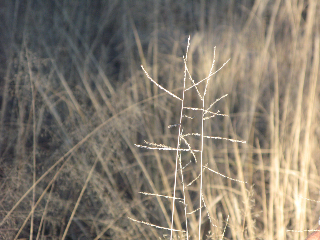I experienced solid ground for the first time at nineteen in a plant taxonomy class at the University of Wisconsin. Gradually as I learned about buds, branching patterns, bark and leaf shapes, the confusing forest of my childhood became a series of individual identifiable trees. In this new world of science a Douglas fir was a Douglas and a White oak was a White oak, This fact was not open for the Fruedian interpretations of my father or the art historical perspectives of my mother.
Now, forty years later as part of Art Lab at El Coronado Ranch I walked through a field of tall dry grasses as Valer Austin, said, “Take a picture. It’s all about the grasses.” As founder of Cuenca Los Ojos Foundation she is restoring hundreds of thousands of acres of the border region to the grasslands it once was before the effects of logging, overgrazing and border wall construction. The over fifteen species of native grasses now thriving on the Austin’s massive ranch as a result of water conservation and management–provide nourishment for their cattle and wildlife of all kinds as it protects the soil from erosion.
The next day I walked through the same field of tall dry grasses with my sketchbook and camera to see how many kinds I could identify. Turns out there were nine species within reach on the hillside where I sat. I looked, made drawings and took pictures and video. I didn’t know what the distinguishing traits were so I looked carefully and recorded everything I could see.
A few hours later returning to the ranch the same field was now populated by groups of fluffy ones, tuft-y ones, three branching ones, many branching ones, reddish ones, sticker-y ones, delicate ones, stiff ones, and fountain-y ones… grasses I had come to know by character but not yet by name. After I studied the guidebook and got help from the Austins I went back out to walk through the same field which had been transformed by my new knowledge into Weeping lovegrass, Slender Grama, Feather fingergrass, Green Sprangletop, Tanglehead, Plains Mountain Blue Grass, Poverty threeawn, Deer Grass, and Squirreltail.
The second day I went out with the intention of drawing and photographing more of the diversity of grasses on the ranch but it didn’t happen. Perhaps I had established sufficient ground the day before. Instead, taken by the gentle movement of the grasses in the soft breeze, I shot video. When my memory card was full I went back to my room and picked up my reading, Seeing is Forgetting the Name of the Thing One Sees by Lawrence Weschler.
Bathed in the contradictions between my reading and my experience, I don’t expect to understand the relationships between seeing, knowing, naming and forgetting any time soon. But now when I take my weekly walks up Tumamoc Hill, I’ll think about Dr. Ray Turner and know I am surrounded by the oldest desert vegetation study plots in the world. When I look out over a section of the desert infested with Bufflegrass I’ll know that all of the native vegetation could be wiped out by a single fire. Now I know that over 100,000 people come to the Biosphere annually, many because of the human drama associated with the Biospherians, and they learn about how useful it is as a model for interdisciplinary climate change research. I have a good sense of the multiple stresses on the Southwest environment and the urgent need for more public dialogue and understanding about the trade offs. Occasionally I will think about every living thing on earth having once been part of a star.
In Seeing is Forgetting the Name of the Thing One Sees, Robert Irwin talks about the reasoning in art making and the logic of scientific research. Is the shift I made between naming the grasses the first day and seeing their character in motion the second a tiny example of the shift between logic and reason? How do the qualities and characters of art and science overlap and differ, support each other and work at cross-purposes? Art Lab has been informative and thought provoking. Maybe the work that comes from the experience we shared will shed some light on these questions and relationships.



